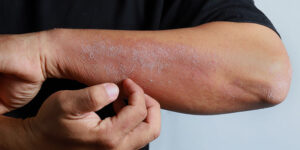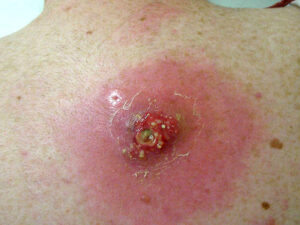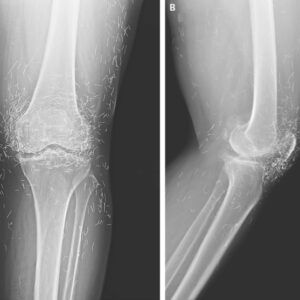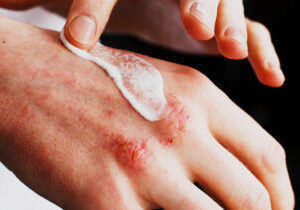Various pathogens can cause skin infections, such as bacteria, viruses, fungi, and parasites. The symptoms, treatment, and outlook will depend on the cause.
Infections can vary from mild to serious. Most skin infections are highly treatable. However, an infection can become more serious if it goes deeper into the skin or spreads across much of the body.
People with a weakened immune system have a higher risk of skin infections and complications from skin infections. This could be due to:
a health condition, such as HIV, diabetes, poor circulation, or malnutrition
a side effect of medication, such as chemotherapy or biologic drug use
being older or very young
have skin folds due to obesity
Over-the-counter medications and home remedies can often treat mild infections, but other infections may need medical attention.
Read on to learn more about skin infections and what to do if you have one.
Pictures of skin infections


What are the types of skin infections?
The following are four different types of skin infections:
1. Bacterial skin infections
Bacterial skin infections occur when bacteria enter the skin, either from an outside source or because they are present on the skin. They can enter the skin through a hair follicle or after a wound.
Anthrax is one type of bacterium that can enter from the environment. Staphylococcus and Streptococcus are bacteria that are commonly present on the skin and only cause a problem in certain circumstances. Lyme disease is a tick-borne infection that causes skin symptoms.
Bacterial infections can be systemic or local. Systemic infections can cause symptoms throughout the whole body, such as a fever, while local infections only affect a specific area. Some bacterial infections can begin in one area and spread throughout the body.
Some bacterial skin infections, such as impetigo, can spread between people through direct skin contact or with bodily fluids, contaminated food or water, or by touching surfaces where bacteria are present. Others, such as cellulitis, are not contagious.
Different types of bacterial skin infections include:
cellulitis
impetigo
boils
Hansen’s disease (leprosy)
Systemic infections that can cause skin rashes include:
syphilis
tuberculosis
leptospirosis
Some bacterial infections are mild and easy to treat with topical antibiotics, but other infections require an oral antibiotic or other medical treatment.
2. Viral skin infections
Viruses can cause different types of infections that have skin symptoms, such as:
shingles (herpes zoster)
chickenpox
Molluscum contagiosum
warts
measles
hand, foot, and mouth disease
These viruses are often contagious, and most are systemic.
3. Fungal skin infections
These types of skin infections are caused by a fungus and are most likely to develop in moist areas of the body where surfaces meet, such as the feet, armpit, or where there are skin folds.
In some cases, an allergy to the fungus causes symptoms in other areas that are not directly affected. For instance, a person with a fungal infection on the foot might develop a rash on their fingers. It doesn’t happen because the person touched their foot.
Different types of fungal infections:
athlete’s foot
yeast infection
ringworm
nail fungus
oral thrush
diaper rash
4. Parasitic skin infection
These types of skin infections are caused by a parasite. These infections can spread beyond the skin to the bloodstream and organs. A parasitic infection isn’t life-threatening but can be uncomfortable.
Different types of parasitic skin infections include:
lice
bedbugs
scabies
cutaneous larva migrans
What are the symptoms of a skin infection?
The symptoms of a skin infection will depend on:
the type of infection
the cause
individual factors, such as whether the person has a weakened immune system
Common symptoms of skin infections include:
redness on pales skin, or purple or darker areas of skin if you have a darker skin tone
lesions that may be flat or raised, bumpy, wart-like, and so on
itching
pain and tenderness
In some cases, a person may also have other symptoms, such as a fever.
Signs of a severe infection include:
pus
blisters
skin sloughing, breakdown
dark areas that can indicate necrosis or tissue death
pain and discoloration
widespread swelling
Is this rash an infection or another skin disorder?
Causes and risk factors for a skin infection
Some types of pathogens — notably bacteria and fungi — are typically present on the skin, but if they become too numerous, the immune system can no longer manage them.
In this case, an infection can result.
The cause of a skin infection depends on the pathogen involved.
Bacterial skin infection
These infections occur when bacteria enter the body through a break in the skin, such as a cut or a scratch.
Not all cuts or scratches lead to a skin infection, but there is a higher risk if you:
have a weakened immune system
do not keep the wound clean
are exposed to certain bacteria, for example, when working outside
Viral skin infection
The most common viruses come from one of three groups of viruses:
poxviruses, such asTrusted Source:
molluscum contagiosum
smallpox
Mpox
human papillomavirus (HPV), responsible for genital warts
herpes viruses, which can lead to
herpex simplex viruses (HSV)
varicella-zoster virus, which causes chickenpox and shingles
Epstein-Barr virus (EBV) which can lead to mononucleosis
cytomegalovirus (CMV)
Experts still don’t know how prevalent viruses are on the skin, unlike bacteria and fungi.
Fungal infection
Body chemistry and lifestyle factors can increase the risk of a fungal infection. Fungi often grow in warm, moist environments.
Some risk factors for a fungal infection are:
having sweaty feet or wearing closed footwear
wearing sweaty or wet clothes
having skin folds due to excess body fat
bathing in contaminated water
sharing personal items with other people who carry a fungus or have an infection
A break or cut in the skin may allow pathogens to get into the deeper layers of the skin.
Parasitic skin infection
Tiny insects or organisms burrowing underneath your skin and laying eggs can cause a parasitic skin infection.
Examples include:
Scabies: An infestation of mites, which causes itching, a rash of small pimples, lines on the skin surface, and scaling or crusty skin.
Pediculosis: This is an infection caused by lice. It can cause itching, and lice and nits — their eggs — may be visible.
Creeping eruption: Caused by hookworms, this can cause a winding, snake-like rash.
Diagnosis
Often, doctors can identify the type of skin infection based on their appearance and location.
The doctor may:
ask about symptoms
examine any bumps, rashes, or lesions
take a sample of skin cells for testing in a laboratory
When to see a doctor
See a doctor if you have:
pus-filled blisters
severe or widespread swelling or inflammation
a skin infection that doesn’t improve or gets progressively worse
a high fever or other symptoms
frequent or recurring rashes or infections
Skin infections can spread beyond the skin and into tissues under the skin or the bloodstream, especially in people with a compromised immune system.
When this happens it can lead to sepsis, a potentially life-threatening condition.
If you need help finding a dermatologist, then check out our FindCare tool here.
Treatment
Treatment depends on the cause of the infection and the severity.
Some infections will go away on their own or respond to over-the-counter creams.
If an infection is severe, the person is at risk of complications, or the infection is contagious, a doctor may prescribe medication such as:
antibiotics
antivirals
antifungals
antiparasitics
The form of the medication will partially depend on the severity of the infection or the risk of complications. A person with a severe infection may need to spend time in the hospital.
Home care and alternative treatments
Home care for a skin infection works to reduce symptoms.
Here are some tips:
Apply cold compresses to your skin several times a day to reduce itching and inflammation.
Take over-the-counter antihistamines to decrease itching.
Use topical creams and ointment to reduce itching and discomfort.
Outlook for a skin infection
The outlook will depend on the cause, type, and severity of the infection.
Many skin infections respond well to medication. However, some conditions, such as methicillin-resistant Staphylococcus aureus (MRSA), are resistant to common antibiotics and harder to treat.
Skin infection prevention
Ways of reducing the risk of a skin infection or rash include:
washing regularly
drying the body to remove all moisture
avoiding sharing personal items with other people
checking the skin regularly for changes and seeking advice as soon as signs of an infection appear
having the recommended vaccinations to prevent diseases such as chickenpox
Frequently asked questions
What are the five main types of skin infections?
Skin infections can be:
bacterial, commonly caused by Streptococcal or Staphylococcal bacteria
viral, such as chickenpox or warts
fungal, for instance, a yeast infection
parasitic, for example, scabies
What does a bacterial skin infection look like?
This will depend on the infection, but it will usually involve inflammation – reddness and swelling.
What is the most common bacterial infection of the skin?
Impetigo is a common example of a bacterial infection. Others include cellulitis and Lyme disease. The most common bacteria associated with skin infections are the Staphylococcus and Streptococcus species.
Takeaway
Skin infections can result from bacterial, viral, fungal, and parasitic causes. The way they affect the body will depend on the specific pathogen. Some cause skin symptoms as part of a wider infection, while others cause local symptoms only.
Skin infections are often highly treatable, but severe symptoms and complications can arise if a person has a weakened immune system.
Some infections are are contagious, such as scabies, and people need to take care not to pass them on before or during treatment.
See your doctor if you have any concerns about signs of a skin infection.





